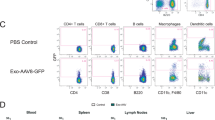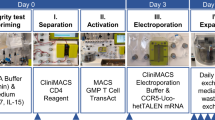Abstract
Interactions between CD40 and CD40 ligand (CD154) are essential in the regulation of both humoral and cellular immune responses. Forced expression of human CD154 in B chronic lymphocytic leukemia (B-CLL) cells can upregulate costimulatory and adhesion molecules and restore antigen-presenting capacity. Unfortunately, B-CLL cells are resistant to direct gene manipulation with most currently available gene transfer systems. In this report, we describe the use of a nonviral, clinical-grade, electroporation-based gene delivery system and a standard plasmid carrying CD154 cDNA, which achieved efficient (64±15%) and rapid (within 3 h) transfection of primary B-CLL cells. Consistent results were obtained from multiple human donors. Transfection of CD154 was functional in that it led to upregulated expression of CD80, CD86, ICAM-I and MHC class II (HLA-DR) on the B-CLL cells and induction of allogeneic immune responses in MLR assays. Furthermore, sustained transgene expression was demonstrated in long-term cryopreserved transfected cells. This simple and rapid gene delivery technology has been validated under the current Good Manufacturing Practice conditions, and multiple doses of CD154-expressing cells were prepared for CLL patients from one DNA transfection. Vaccination strategies using autologous tumor cells manipulated ex vivo for patients with B-CLL and perhaps with other hematopoietic malignancies could be practically implemented using this rapid and efficient nonviral gene delivery system.
This is a preview of subscription content, access via your institution
Access options
Subscribe to this journal
Receive 12 print issues and online access
$259.00 per year
only $21.58 per issue
Buy this article
- Purchase on Springer Link
- Instant access to full article PDF
Prices may be subject to local taxes which are calculated during checkout







Similar content being viewed by others
References
Keating MJ, Chiorazzi N, Messmer B, Damle RN, Allen SL, Rai KR et al. Biology and treatment of chronic lymphocytic leukemia. Hematology (Am Soc Hematol Educ Program) 2003: 153–175.
Byrd JC, Stilgenbauer S, Flinn IW . Chronic lymphocytic leukemia. Hematology (Am Soc Hematol Educ Program) 2004: 163–183.
Kipps TJ, Chu P, Wierda WG . Immunogenetic therapy for B-cell malignancies. Semin Oncol 2000; 27(6 Suppl 12): 104–109.
Ranheim EA, Kipps TJ . Activated T cells induce expression of B7/BB1 on normal or leukemic B cells through a CD40-dependent signal. J Exp Med 1993; 177(4): 925–935.
Kato K, Cantwell MJ, Sharma S, Kipps TJ . Gene transfer of CD40-ligand induces autologous immune recognition of chronic lymphocytic leukemia B cells. J Clin Invest 1998; 101(5): 1133–1141.
Biagi E, Yvon E, Dotti G, Amrolia PJ, Takahashi S, Popat U et al. Bystander transfer of functional human CD40 ligand from gene-modified fibroblasts to B-chronic lymphocytic leukemia cells. Hum Gene Ther 2003; 14(6): 545–559.
Takahashi S, Rousseau RF, Yotnda P, Mei Z, Dotti G, Rill D et al. Autologous antileukemic immune response induced by chronic lymphocytic leukemia B cells expressing the CD40 ligand and interleukin 2 transgenes. Hum Gene Ther 2001; 12(6): 659–670.
Cantwell MJ, Wierda WG, Lossos IS, Levy R, Kipps TJ . T cell activation following infection of primary follicle center lymphoma B cells with adenovirus encoding CD154. Leukemia 2001; 15(9): 1451–1457.
Buhmann R, Nolte A, Westhaus D, Emmerich B, Hallek M . CD40-activated B-cell chronic lymphocytic leukemia cells for tumor immunotherapy: stimulation of allogeneic versus autologous T cells generates different types of effector cells. Blood 1999; 93(6): 1992–2002.
Fanslow WC, Srinivasan S, Paxton R, Gibson MG, Spriggs MK, Armitage RJ . Structural characteristics of CD40 ligand that determine biological function. Semin Immunol 1994; 6(5): 267–278.
Castle BE, Kishimoto K, Stearns C, Brown ML, Kehry MR . Regulation of expression of the ligand for CD40 on T helper lymphocytes. J Immunol 1993; 151(4): 1777–1788.
Tong AW, Stone MJ . Prospects for CD40-directed experimental therapy of human cancer. Cancer Gene Ther 2003; 10(1): 1–13.
Banchereau J, Bazan F, Blanchard D, Briere F, Galizzi JP, van Kooten C et al. The CD40 antigen and its ligand. Annu Rev Immunol 1994; 12: 881–922.
Yellin MJ, Sinning J, Covey LR, Sherman W, Lee JJ, Glickman-Nir E et al. T lymphocyte T cell–B cell-activating molecule/CD40-L molecules induce normal B cells or chronic lymphocytic leukemia B cells to express CD80 (B7/BB-1) and enhance their costimulatory activity. J Immunol 1994; 153(2): 666–674.
von Bergwelt-Baildon MS, Vonderheide RH, Maecker B, Hirano N, Anderson KS, Butler MO et al. Human primary and memory cytotoxic T lymphocyte responses are efficiently induced by means of CD40-activated B cells as antigen-presenting cells: potential for clinical application. Blood 2002; 99(9): 3319–3325.
van Essen D, Kikutani H, Gray D . CD40 ligand-transduced co-stimulation of T cells in the development of helper function. Nature 1995; 378(6557): 620–623.
Bennett SR, Carbone FR, Karamalis F, Flavell RA, Miller JF, Heath WR . Help for cytotoxic-T-cell responses is mediated by CD40 signalling. Nature 1998; 393(6684): 478–480.
Schoenberger SP, Toes RE, van der Voort EI, Offringa R, Melief CJ . T-cell help for cytotoxic T lymphocytes is mediated by CD40–CD40L interactions. Nature 1998; 393(6684): 480–483.
Cantwell M, Hua T, Pappas J, Kipps TJ . Acquired CD40-ligand deficiency in chronic lymphocytic leukemia. Nat Med 1997; 3(9): 984–989.
Schattner EJ, Mascarenhas J, Reyfman I, Koshy M, Woo C, Friedman SM et al. Chronic lymphocytic leukemia B cells can express CD40 ligand and demonstrate T-cell type costimulatory capacity. Blood 1998; 91(8): 2689–2697.
Cantwell MJ, Sharma S, Friedmann T, Kipps TJ . Adenovirus vector infection of chronic lymphocytic leukemia B cells. Blood 1996; 88(12): 4676–4683.
Wierda WG, Cantwell MJ, Woods SJ, Rassenti LZ, Prussak CE, Kipps TJ . CD40-ligand (CD154) gene therapy for chronic lymphocytic leukemia. Blood 2000; 96(9): 2917–2924.
Theiss HD, Kofler DM, Buning H, Aldenhoff AL, Kaess B, Decker T et al. Enhancement of gene transfer with recombinant adeno-associated virus (rAAV) vectors into primary B-cell chronic lymphocytic leukemia cells by CpG-oligodeoxynucleotides. Exp Hematol 2003; 31(12): 1223–1229.
Wendtner CM, Kofler DM, Theiss HD, Kurzeder C, Buhmann R, Schweighofer C et al. Efficient gene transfer of CD40 ligand into primary B-CLL cells using recombinant adeno-associated virus (rAAV) vectors. Blood 2002; 100(5): 1655–1661.
Wendtner CM, Kofler DM, Mayr C, Bund D, Hallek M . The potential of gene transfer into primary B-CLL cells using recombinant virus vectors. Leuk Lymphoma 2004; 45(5): 897–904.
Wendtner CM, Kurzeder C, Theiss HD, Kofler DM, Baumert J, Delecluse HJ et al. High level of transgene expression in primary chronic lymphocytic leukemia cells using helper-virus-free recombinant Epstein–Barr virus vectors. Exp Hematol 2003; 31(2): 99–108.
Tolba KA, Bowers WJ, Hilchey SP, Halterman MW, Howard DF, Giuliano RE et al. Development of herpes simplex virus-1 amplicon-based immunotherapy for chronic lymphocytic leukemia. Blood 2001; 98(2): 287–295.
Hui SW, Li LH . In vitro and ex vivo delivery of genes to cells by electroporation. In: Jaroszeski MJ, Gilbert R, Heller R (eds.), Electrically Mediated Delivery of Molecules to Cells: Electrochemotherapy, Electrogene Therapy and Transdermal Delivery by Electroporation. Totowa, NJ: Humana Press; 2000, pp. 157–172.
Neumann E, Schaefer-Ridder M, Wang Y, Hofschneider PH . Gene transfer into mouse lyoma cells by electroporation in high electric fields. EMBO J 1982; 1(7): 841–845.
Zimmermann U . Electrical breakdown, electropermeabilization and electrofusion. Rev Physiol Biochem Pharmacol 1986; 105: 176–256.
Golzio M, Rols MP, Teissie J . In vitro and in vivo electric field-mediated permeabilization, gene transfer, and expression. Methods 2004; 33(2): 126–135.
Klenchin VA, Sukharev SI, Serov SM, Chernomordik LV, Chizmadzhev Yu A . Electrically induced DNA uptake by cells is a fast process involving DNA electrophoresis. Biophys J 1991; 60(4): 804–811.
Xie TD, Sun L, Tsong TY . Study of mechanisms of electric field-induced DNA transfection. I. DNA entry by surface binding and diffusion through membrane pores. Biophys J 1990; 58(1): 13–19.
Weiss JM, Shivakumar R, Feller S, Li LH, Hanson A, Fogler WE et al. Rapid, in vivo, evaluation of antiangiogenic and antineoplastic gene products by nonviral transfection of tumor cells. Cancer Gene Ther 2004; 11(5): 346–353.
Li LH, Shivakumar R, Feller S, Allen C, Weiss JM, Dzekunov S et al. Highly efficient, large volume flow electroporation. Technol Cancer Res Treat 2002; 1(5): 341–350.
Heller R, Coppola D, Pottinger C, Gilbert R, Jaroszeski MJ . Effect of electrochemotherapy on muscle and skin. Technol Cancer Res Treat 2002; 1(5): 385–392.
Mir LM, Glass LF, Sersa G, Teissie J, Domenge C, Miklavcic D et al. Effective treatment of cutaneous and subcutaneous malignant tumours by electrochemotherapy. Br J Cancer 1998; 77(12): 2336–2342.
Wells JM, Li LH, Sen A, Jahreis GP, Hui SW . Electroporation-enhanced gene delivery in mammary tumors. Gene Therapy 2000; 7(7): 541–547.
Fratantoni JC, Dzekunov S, Singh V, Liu LN . A non-viral gene delivery system designed for clinical use. Cytotherapy 2003; 5(3): 208–210.
Fratantoni JC DS, Wang S, Liu LN . A scalable cell-loading system for non-viral gene delivery and other applications. Bioprocess J 2004; 3: 49–54.
Anderson ML, Spandidos DA, Coggins JR . Electroporation of lymphoid cells: factors affecting the efficiency of transfection. J Biochem Biophys Methods 1991; 22(3): 207–222.
Shimokawa T, Okumura K, Ra C . DNA induces apoptosis in electroporated human promonocytic cell line U937. Biochem Biophys Res Commun 2000; 270(1): 94–99.
Li LH, McCarthy P, Hui SW . High-efficiency electrotransfection of human primary hematopoietic stem cells. FASEB J 2001; 15(3): 586–588.
Li LH, Sen A, Murphy SP, Jahreis GP, Fuji H, Hui SW . Apoptosis induced by DNA uptake limits transfection efficiency. Exp Cell Res 1999; 253(2): 541–550.
Adams JM . Ways of dying: multiple pathways to apoptosis. Genes Dev 2003; 17(20): 2481–2495.
Waxman DJ, Schwartz PS . Harnessing apoptosis for improved anticancer gene therapy. Cancer Res 2003; 63(24): 8563–8572.
Yang T, Witham TF, Villa L, Erff M, Attanucci J, Watkins S et al. Glioma-associated hyaluronan induces apoptosis in dendritic cells via inducible nitric oxide synthase: implications for the use of dendritic cells for therapy of gliomas. Cancer Res 2002; 62(9): 2583–2591.
Dotti G, Savoldo B, Takahashi S, Goltsova T, Brown M, Rill D et al. Adenovector-induced expression of human-CD40-ligand (hCD40L) by multiple myeloma cells. A model for immunotherapy. Exp Hematol 2001; 29(8): 952–961.
McLellan AD, Sorg RV, Williams LA, Hart DN . Human dendritic cells activate T lymphocytes via a CD40:CD40 ligand-dependent pathway. Eur J Immunol 1996; 26(6): 1204–1210.
Kokhaei P, Rezvany MR, Virving L, Choudhury A, Rabbani H, Osterborg A et al. Dendritic cells loaded with apoptotic tumour cells induce a stronger T-cell response than dendritic cell-tumour hybrids in B-CLL. Leukemia 2003; 17(5): 894–899.
Goldszmid RS, Idoyaga J, Bravo AI, Steinman R, Mordoh J, Wainstok R . Dendritic cells charged with apoptotic tumor cells induce long-lived protective CD4+ and CD8+ T cell immunity against B16 melanoma. J Immunol 2003; 171(11): 5940–5947.
Strome SE, Voss S, Wilcox R, Wakefield TL, Tamada K, Flies D et al. Strategies for antigen loading of dendritic cells to enhance the antitumor immune response. Cancer Res 2002; 62(6): 1884–1889.
Acknowledgements
We thank Dr Malcolm K Brenner for comments on the manuscript, and Nicholas Chopas, Sarah Wang, Nat Forgotson and Sergey Dzekunov for instrumentation support.
Author information
Authors and Affiliations
Corresponding author
Rights and permissions
About this article
Cite this article
Li, L., Biagi, E., Allen, C. et al. Rapid and efficient nonviral gene delivery of CD154 to primary chronic lymphocytic leukemia cells. Cancer Gene Ther 13, 215–224 (2006). https://doi.org/10.1038/sj.cgt.7700883
Received:
Revised:
Accepted:
Published:
Issue Date:
DOI: https://doi.org/10.1038/sj.cgt.7700883
Keywords
This article is cited by
-
Biomanufacturing for clinically advanced cell therapies
Nature Biomedical Engineering (2018)
-
Advances in the Field of Lentivector-based Transduction of T and B Lymphocytes for Gene Therapy
Molecular Therapy (2010)
-
Expression of chimeric antigen receptors in natural killer cells with a regulatory-compliant non-viral method
Cancer Gene Therapy (2010)
-
Efficient gene transfer in CLL by mRNA electroporation
Leukemia (2008)



